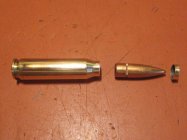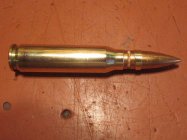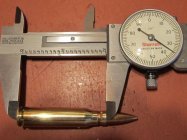Gentlemen,
If I may...the carbon that sometimes bites us, that is in the very front of the chamber is just powder fouling that a bore sized brush has missed.
Recently, to address this, I followed some advice that I have known about for some time, but due to being in somewhat of a rut, I had failed to follow. After doing a normal cleaning on a well broken in, but un heat cracked 6PPC barrel, that had only been fired a few rounds since its last cleaning, I put a fairly fresh 6.5mm bronze brush on one of my chamber rods, shoved it to what felt like a fraction of an inch past the front of the chamber neck, and gave it a couple of dozen partial turns, switched to a 6mm brush, shoved it a mite farther, and repeated the same thing, then I wiped out the chamber and leade area with a strip of paper toweling wrapped to a loose, oversized cone shape, over the 6MM brush (my usual chamber wiping method at the end of a barrel's cleaning). What I saw on the paper toweling was evidence that the brushing had dislodged some powder fouling at the front of the neck, that my regular cleaning with a new bronze brush had missed. This motivated me to make a change in my decades old cleaning procedure. I ordered an inexpensive one piece stainless cleaning rod using Amazon Prime (for about $9 delivered) and plan on cutting it off to a length such that it will extend past the butt of all of my rifles' stocks when a brush that is mounted on it is at the front of which ever chamber I am using it on. The plan is to use my cheap, somewhat slow, cordless drill to spin a brush for perhaps five seconds, at the front of the chamber. Others have reported doing this with good results, and I do not think that it should hurt anything if done carefully. Due to the fact that most of my shooting in this caliber has been with 133, I have not had problems with a hard carbon ring a little farther forward, but I have seen one or two trying to get started in one or two of my other rifles, something a little very careful work with IOSSO remedied. I have the use of a bore scope, but do not use it every time that I clean. Generally, when I have scoped my barrels, they have passed inspection with flying colors, but I am going to modify my procedure anyway, just to see if it changes my results in any way.
I think that the main thing that we need to do to get away from fliers caused by powder fouling buildup at the front of the case neck, is to trim often so that cases will be of uniform length, not just to maintain some clearance (Neary speaks to this.). and to manage and monitor shoulder bump, because cases are blown forward at the beginning of the ignition/firing cycle, with the result that those with more bump will extend farther than those with less, even though they are trimmed to the same length. Recently, when returning some Lapua brass that has some life left in it, but was from an estate, and was probably of mixed usage, I found that because of the variance of work hardening, that my bump, with the same die setting, varied quite a bit, and that that resulted in a variance in trim length using a trimmer that indexed off of the shoulder. At first the variance in trim length bothered me, but then I realized that at least until I had a chance to fire and retrim before sizing, that this was not such a bad thing, since the extension into the chamber neck as the cases were fired would actually be more uniform. In the future, I plan on using these types of trimmers on fired cases to see if the trim length is more uniform. I sorted the cases that were not by amount of bump, using that as an indication of work hardening differences. Within the group there was a large subset that were uniform, and lesser numbers that varied by various amounts. In the past, I have not looked at the uniformity of case bump within sets of cases, I may change that.














